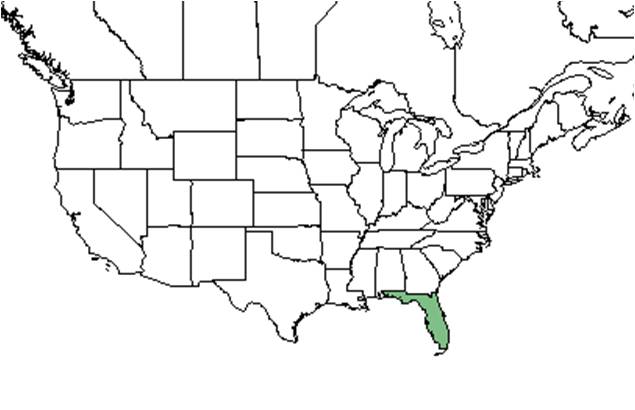Sabal etonia
| Sabal etonia | |
|---|---|

| |
| Photo by Shirley Denton (Copyrighted, use by photographer’s permission only), Nature Photography by Shirley Denton | |
| Scientific classification | |
| Kingdom: | Plantae |
| Division: | Magnoliophyta - Flowering plants |
| Class: | Magnoliopsida – Dicotyledons |
| Order: | Arecales |
| Family: | Arecaceae ⁄ Palmae |
| Genus: | Sabal |
| Species: | S. etonia |
| Binomial name | |
| Sabal etonia Swingle ex Nash | |

| |
| Natural range of Sabal etonia from USDA NRCS Plants Database. | |
Common name: scrub palmetto
Contents
Taxonomic notes
Description
A description of Sabal etonia is provided in The Flora of North America.
S. etonia has a subterranean stem that is S-shaped or contorted, with the crown bud held below the soil surface[1]. This species resembles Serenoa repens, however, S. repens has a true palmate leaf with no midrib and sawlike teeth along the edges of the petiole[2].
Distribution
S. etonia only occurs naturally in the well drained sandy ridges in peninsular Florida[2]. It is distributed in Florida from Clay county south to Lake Okeechobee and then along the east coast south to Miami-Dade county[3].
Ecology
Habitat
In the Coastal Plain in Florida, Sabal etonia occurs in sand pine/oak scrubs[4]. Associated species include Pinus clausa, Ceratiola ericoides, and Quercus ilicifolia. Grows in well-drained sandy soils and entisols[5].
Phenology
Flowers in spring. Fruits are shiny black berries[1].
Seed bank and germination
This species is extremely long lived and experiences limited recruitment of slow-growing seedlings. Both seedlings and adults can persist in drought and wildfire. Seedlings display a type 2 survivorship with constant mortality rates[5].
Fire ecology
S. etonia displays strong postfire flowering responses, this is typical of many monocots[6]. It is very tolerant to fire[7].
Pollination
The following Hymenoptera families and species were observed visiting flowers of Sabal etonia at Archbold Biological Station (Deyrup 2015):
Apidae: Apis mellifera, Bombus pennsylvanicus, Epeolus floridensis, Mellisodes communis, Nomada fervida
Colletidae: Colletes distinctus, C. mandibularis, C. sp. A, Hylaeus confluens
Halictidae: Agapostemon splendens, Augochlorella aurata, Augochloropsis anonyma, A. metallica, Lasioglossum miniatulus, L. nymphalis, L. placidensis, Sphecodes heraclei
Megachilidae: Coelioxys sayi, Megachile albitarsis, M. brevis pseudobrevis, M. mendica, M. texana
Pompilidae: Paracyphonyx funereus
Sphecidae: Cerceris blakei, C. flavofasciata floridensis, Epinysson basilaris, Isodontia exornata, Oxybelus decorosum, Stictiella serrata
Vespidae: Euodynerus boscii boharti, Leptochilus alcolhuus, Mischocyttarus cubensis, Monobia quadridens, Pachodynerus erynnis, Parancistrocerus bicornis, P. salcularis rufulus, Stenodynerus beameri, S. oculeus
Use by animals
Fruits are eaten by birds[1].
Diseases and parasites
Individuals are susceptible to scale, mites and leaf skeletonizers[8].
Photo Gallery
References and notes
Deyrup, M.A. and N.D. 2015. Database of observations of Hymenoptera visitations to flowers of plants on Archbold Biological Station, Florida, USA.
Florida State University Robert K. Godfrey Herbarium database. URL: http://herbarium.bio.fsu.edu. Last accessed: November 2015. Collectors: K.M. Meyer, A. Townesmith. States and Counties: Florida: Putnam. Compiled by Tall Timbers Research Station and Land Conservancy.
- ↑ 1.0 1.1 1.2 [[1]]University of Florida Extension. Accessed: March 10, 2016
- ↑ 2.0 2.1 [[2]]Floridata. Accessed: March 15, 2016
- ↑ [[3]]Regional Conservation. Accessed: March 15, 2016
- ↑ Florida State University Robert K. Godfrey Herbarium database. URL: http://herbarium.bio.fsu.edu. Last accessed: November 2015. Collectors: K.M. Meyer, A. Townesmith. States and Counties: Florida: Putnam. Compiled by Tall Timbers Research Station and Land Conservancy.
- ↑ 5.0 5.1 Abrahamson, W. G. and C. R. Abrahamson (2009). "Life in the Slow Lane: Palmetto Seedlings Exhibit Remarkable Survival but Slow Growth in Florida's Nutrient-Poor Uplands." Castanea 74(2): 123-132.
- ↑ Abrahamson, W. G. (1999). "Episodic Reproduction in Two Fire-Prone Palms, Serenoa repens and Sabal etonia (Palmae)." Ecology 80(1): 100-115.
- ↑ [[4]]Palmpedia. Accessed: March 16, 2016
- ↑ [[5]]Missouri Botanical Gardens. Accessed: March 18, 2016